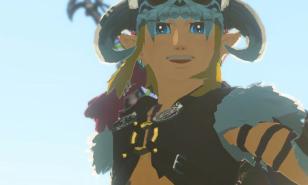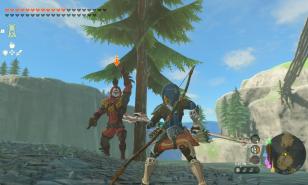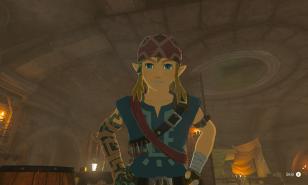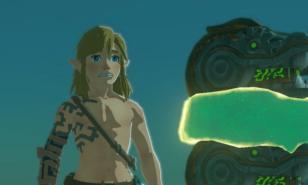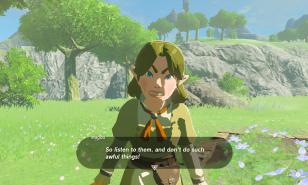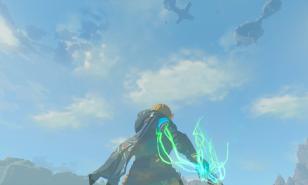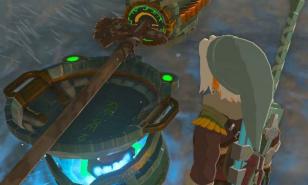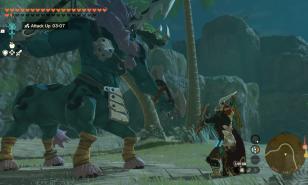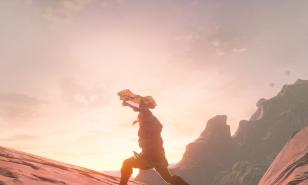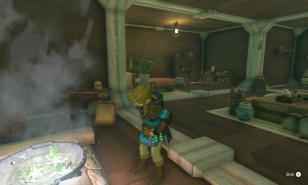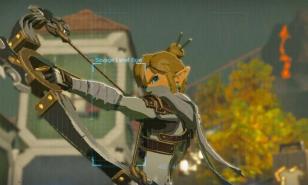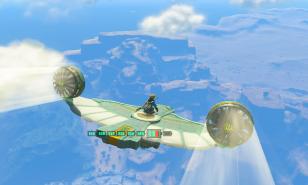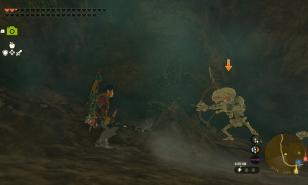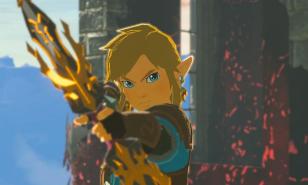Zelda: Tears of the Kingdom Review 2024
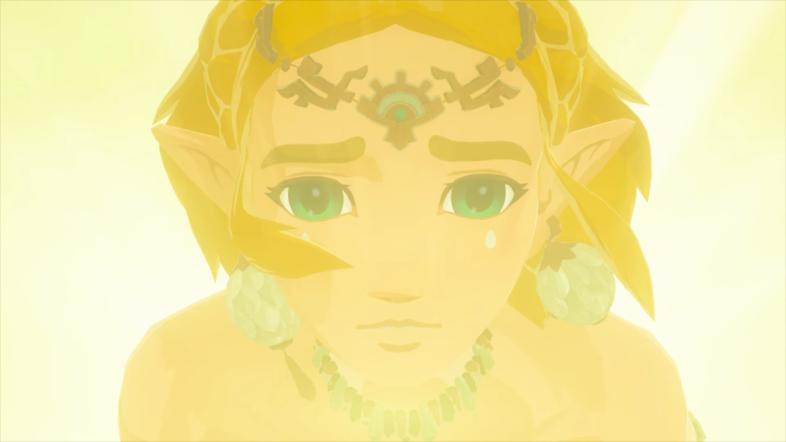
Zelda: Tears of the Kingdom Review 2024
The Legend of Zelda: Tears of the Kingdom is one of the best games to continue playing in 2024. This is a year-in-review of how the game still holds up to continue playing as a solo-player action-adventure game.
I’m reviewing this game based on the story, characters, gameplay, replayability, combat, missions, graphics, development, and cost. The review will oversee the pros and cons of the game in relevant sections.
Introduciton:
The Legend of Zelda: Tears of the Kingdom is an open-world action and adventure RPG. Gamers play as Link as he explores a new Hyrule affected by the Sky’s ruins and the Depth’s gloom.
Link has new abilities that gamers can finally get creative with.
The ability Ascend allows Link to phase through solid matter above him. The ability Recall allows Link to reverse the flow of time with specific objects, such as weapons or moving platforms.
The ability Fuse allows Link to fuse objects onto his weapons to strengthen them. The ability Ultrahand allows Link to move almost all objects and glue them together.
The game was released on May 12, 2023, created and published by Nintendo. Zelda fans were so excited and couldn't wait because they were impressed by the first few Nintendo Direct teasers and trailers.
The Zelda fanbase responded positively when it first launched and loved the overall gameplay because they loved exploring the Sky, the Depths, and the changes in Hyrule's Surface.
For the first few days and weeks after its launch, many YouTube gamers started live streams, shared walkthroughs and guides, and introduced the game in more depth to all types of gamers.
It's still a popular game in 2024 because many articles and YouTube videos will investigate every detail of the game that many need to learn about. There are many aspiring videos on how to make the most epic Autobuild creations.
Tears of the Kingdom is still one of the best-selling Nintendo games. It won game awards for the Best Action/Adventure Game, Most Anticipated Game, Most Wanted Game, and Nintendo Game of the Year.
The game sold 10 million units in 3 days for $69.99. It took about 6 years to develop it, shortly after Breath of the Wild’s success in 2017. The development budget is larger than the Breath of the Wild’s, making more than $120 Million.
The Legend of Zelda: Tears of the Kingdom Story
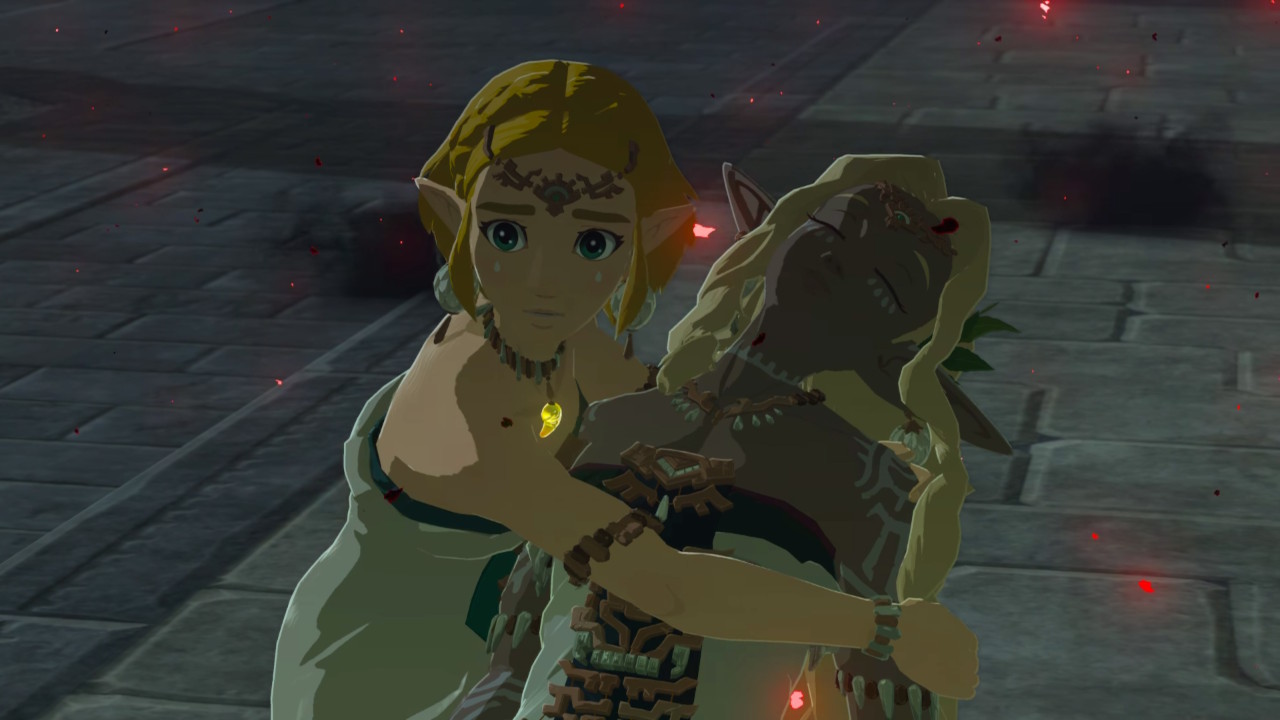
Zelda’s and Sonia’s plan to fool Ganondorf fails!
Here’s a Link to the story recap.
Link and Zelda explore the Depths of Hyrule Castle until Ganondorf, the Demon King, awakes to separate them into different timelines.
Zelda’s journey explores the lost Hyrule in ancient times, and she must find a way to reconnect with Link again in the future.
She trusts Link if he can ever find her through the Skies' clues. She hopes he can defeat the Demon King.
Link must deal with the Demon King’s forces taking over Hyrule and its allies. He doesn't know much about what is happening, such as his new arm abilities.
He must uncover clues from the Skies and Depths to find where Zelda is.
Many obstacles are in his way, such as defeating Ganondorf’s second-in-command monsters terrorizing Hebra, Eldin, Lanayru, and Gerudo. Ganondorf messes with Link’s allies by disguising one of his phantoms into Zelda.
Tears of the Kingdom has more story elements than Breath of the Wild, where gamers try to explore the lore of Hyrule’s ancient past.
The breathtaking Skies and the uncanny Depths keep players engaged in the story through open-world discovery by witnessing most of its ruins.
The Legend of Zelda: Tears of the Kingdom Gameplay:
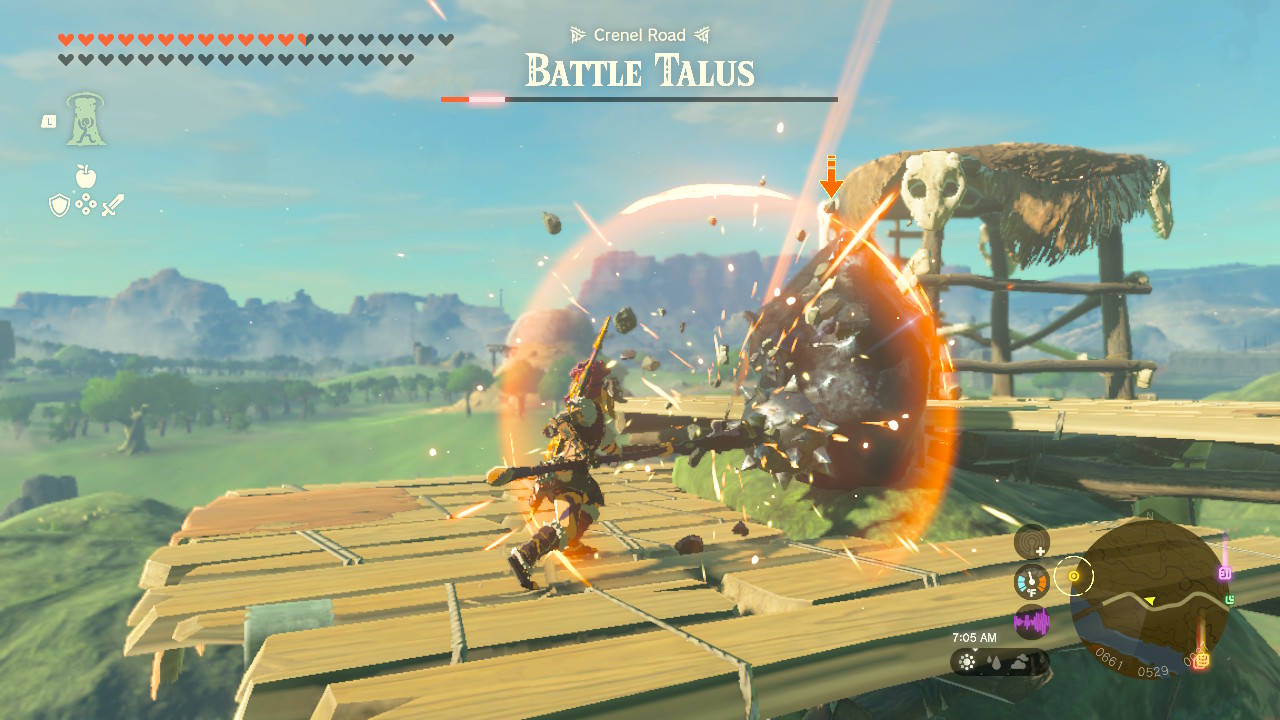
Link crushes a Battle Talus.
Watch some of the Gameplay here
Activities:
Tears of the Kingdom has lots of activities. Following the story, you can expect to follow main quests such as Regional Phenomena to Link defeating Ganondorf.
There are many exciting main quests between those 2 events, such as finding the Dragon’s Tears, Finding the Master Sword, discovering the Secret of the Ring Ruins, and much more.
Gamers get immersed in an engaging Zelda story, learning more about the secrets of the Skies and Depths from Zonai lore and where Zelda is from the lore they discover.
There’s much to explore outside the story because Hyrule is enormous. Lots of discovery is essential to finding great items, food, weapons, armor, treasure, and towns.
There are special things that only live in the Skies or Depths. Sundelions are herbs that live in the Skies and make gloom-heart-recovery meals.
Poes are bright-blue spiritual orbs that are currency when buying various things from Bargainer Statues, such as high-powered weapons and armor.
You can choose to pick your fights. Raiding monster camps is especially fun when using a Zonai-monster killing device. There are many mini-bosses in the Skies, Surface, and Depths.
They are fierce, such as King Gleeoks, Silver Lynels, Blue-White Froxes, and Flux Constructs. You can expect lots of fighting, which will help increase your level scaling!
If you want something peaceful, you can hunt for animals in forests or fish in the open ocean during sunset. You can even go to Tarrey Town and build your own house!
If you want to hustle as a treasure seeker, you can expect to find lots of early armor and early weapons so you can advance further in the game.
There are many side quests and side adventures prompted by NPCs when you interact with them. You learn more about how every NPC has a story affected by the Sky Islands’ ruins and the Depths’ gloom.
You can expect to help NPCs in many ways, such as escorting them somewhere, finding goods for them, and even battling monster forces with them!
Special NPCs, such as Great Fairies, upgrade Link’s armor if you collect the correct materials.
The game usually wants you to get creative with crafting Zonai devices and fuse weapons!
The game is made so well for the Zelda community that the developers have a deep understanding that many players will look on YouTube or read articles about the best Zonai devices and fusions to create.
Many Zelda fans enjoy when Link goes GTA on all his Zonai devices and wields intricate fuse weapons such as Canon Shields.
Map:
Tears of the Kingdom is the largest Zelda map in history. It has 3 layers of maps where Link can travel to the Skies, Surface, and Depths.
There are many regions to explore, such as caves on the surface, abandoned mines in the depths, and floating islands in the skies.
Link can Fast Travel to all these places if he has unlocked Shrines, Skyview Towers, Dungeons, and Lightroots. He can make his own Fast Travel point with the Travel Medallion anywhere in the game. He can only place 3.
NPC's:
Most NPCs live on the Surface, while Link can interact with Steward Constructs in the Skies and Depths, exchanging Zonaite for Zonaite Charge or Crystalized Charge.
Enemy NPCS like the Yiga Clan tend to hang out on the Surface and the Depths. Link can run into them unexpectedly.
Normal NPCs live on the surface, and Link can start exciting side quests or adventures. NPCs usually have stories and ask for Link’s help to solve problems.
Some can be fun, such as Village Attacked by Pirates, where Link has to free Lurelin village from Bokoblin pirates. After completing many side quests or adventures, Link earns rewards such as meals, elixirs, rupees, and unique items.
Other NPCs he can interact with are the Goddess Statues, which give health and stamina when presenting a light of blessing. Another example is the Koroks, who give Link Korok Seeds after solving their puzzles.
Although it is a long process, Korok Seeds helps him increase his inventory. In TOTK, you can now help Koroks reach their friend, or you can kidnap and torture them for making the inventory process such a chore.
The NPC's make things exciting by having Side Quests and Side Adventures available. Some are 100% worth doing, while others are sometimes boring chores.
Some Side Adventures tell a great, heartwarming story, such as Mattison's Independence, where Link helps a family overcome their fear of Mattison growing up and living in Gerudo town.
By helping them, the parents offer Link a business to build his house at a discount. This allows gamers to build their dream home in Hyrule.
Side Quests, such as Gloom Borne Illness, provide insight into how characters are affected by Gloom. Link travels to Kakariko Village and helps Lasli's Grandmother, Nanna.
Nanna's sick from Gloom and needs a gloom-heart-recovery meal. As a result, Lasli will drop the price of the Stealth Armor, making it more affordable.
There are antagonist NPC's, such as the annoying Yiga Clan. They are one of the most funny and entertaining NPC's because they are horrible at disguise.
They're annoying on purpose, and their powers are much stronger than in BOTW. They have enemy camps on the Surface and Depths.
Their leader is Master Kohga, and he is an improved villain because he helps make TOTK a sequel. In BOTW, Link defeats him as he falls into a dark pit, but now Master Kohga is up to more evil mischief, aiding the Demon King.
Related to the Yiga Clan, the game lets Link disguise as a Yiga Clan member and infiltrate them from within. There are Yiga Clan-related side quests where gamers can understand their perspective.
What needed most improvement:
Shrines
The dungeons and shrines needed the most improvement. Each has weaknesses and strengths but shares similar issues regarding the purpose of the puzzle.
The shrines are well-developed in terms of location and variety. Shrine Quests are the most exciting because they lead to Rauru's Blessings.
They have some purposeful interactive puzzles, such as bringing the green crystal carefully back from a very high floating island. Some green crystals were on Flux Constructs.
Other exciting shrines are Combat shrines, where Link learns how to fight in certain scenarios. Another is the Proving Ground Shrines, where Link tests his skills without any armor or inventory.
Normal shrines provide complex puzzles to get to the Light of Blessing. They suffer the most because when gamers start farming rocket shields or spring shields, they can solve all the shrines.
For example, the Ishodag Shrine: A Windy Device prompts you to build a boat to cross the water and reach the Light of Blessing.
If you have a rocket shield or spring shield in your inventory, you don't need to interact with the puzzle because you can go high up and safely glide to the Light of Blessing.
It feels strange because, by the shrine's design, the developers wanted to do 2 things. They want gamers to utilize fuse cheat codes to solve the shrine.
They also wanted to introduce new Ultrahand creations through the puzzles. While it creates an oxymoron, it makes gamers dismiss the puzzles and Ultrahnd ideas when encouraged to cheat the shrine.
Even if gamers don't have to use rocket shields to solve it, the puzzles become purposeless when you have solutions pre-made in your inventory.
What needed more improvement was if the developers could alter most of the normal shrines similar to Proving Ground shrines, where Link has zero inventory.
Then, interactions with the puzzles would have more purpose, and gamers can learn more about what they can create with Ultrahand.
Dungeons
The temple dungeons presented a few great things in Tears of the Kingdom. The developers understood that in the past Zelda game, Breath of the Wild, the dungeon interiors looked the same and had a similar layout.
In Tears of the Kingdom, they are more well thought out in terms of layout and design.
For example, the Water Temple dungeon is outside and is a pristine and elegant sky island. It has other sky islands surrounding it and has waterfalls to make it look unique.
The Wind Temple dungeon is an ark with grand halls inside it with turbines. It has airships surrounding the ark.
The Fire Temple dungeon is an open dungeon in the Depths, with many scattered ruins surrounded by lava. The Lightning Temple dungeon is a pyramid with many dim-lit hidden rooms, stair levels, and traps.
The Spirit Temple is a dark and mysterious temple filled with Zonai lore and has a massive room in a pit. All dungeons have excellent atmospheres, making them worth exploring.
The upsetting part of the temple dungeons is that there is no consistent level of risk to solving the temple's puzzles, and nothing stops Link from solving them.
To succeed, you must use Link's ally's abilities to unlock puzzles in the dungeon. The solution is usually next to the puzzle, such as a loose part fixing a turbine in the Wind Temple.
No enemies guard that area besides areas where there is treasure. Other temples leave other puzzle areas more open-ended, where enemies aren't guarding them.
However, this is not necessarily true in all dungeon rooms. The only temple dungeons immune to lack of risk are the Lightning Temple and Spirit Temple.
For example, the Lightning Temple has the most Soldier Constructs guarding the rooms with the puzzles, besides the first room on the 1'st level. There is a lot to move around because to solve the Lightning Temple's puzzles, you must use Zonai mirrors to redirect light to a target to open a door. Soldier Constructs and traps prevent Link from progressing, forcing a fight or flight instinct because there are more threats in the dungeon.
The Spirit Temple has no puzzles and is the location of the Seized Construct boss fight.
A few enemies guard the puzzles on level 1F in the Water Temple on different wings. 1 Chucu Jelly guards the puzzle on the upper west wing of the temple. 2 Soldiers Constructs with bows and a Chucu Jelly guard the lower east wing of the temple. No enemies are present on the other levels of the water temple where the puzzle is. A trap-like area on the lowest level has idle traps, such as bursting fire at the entrance and ground spikes toward the puzzle's sphere. With a temple dungeon in the sky, enemies should have threatened to push Link off to make it more threatening.
The Fire Temple has no enemies guarding the room with the puzzle besides a Soldier Construct with a bow on a minecart on level 4F. The lava and the extreme heat are other factors that make this dungeon risky, but it lacks risk because no enemies or traps try to push you into the lava.
The Wind Temple has obscure elements where Soldier Constructs guard treasure or hallways and are further away from the puzzles. For example, the only Soldier Construct guarding a wind turbine is on level B2. A Soldier Construct on level 1F is guarding treasure when it is a few feet away from a puzzle and a wind turbine. The Wind Temple has neat traps with lasers. If Link touches it, he falls or can't get to the puzzle.This formula repeats only twice inside the ark's body and its tall chimney. There should have been more, and the Soldier Constructs should have been more threatening to guard the puzzles or try to push Link off the ark.
In conclusion, there's no consistent risk when solving puzzles in the temple dungeons. Many enemies could have been organized in the rooms with the puzzles, such as the Lightning Temple, which forces gamers to face enemies and adapt to hostile environments to finish a puzzle.
Replayability:
Tears of the Kingdom is very replayable because, similar to Breath of the Wild, there is more to explore when you finish the story. You can finish tackling side quests and side adventures you haven't encountered.
You can search for all the wells or caves. You can create more elaborate Zonai devices you haven't tried yet. Many fans are enthusiastic about building Zonai monster-killing devices.
Dare to attempt coliseum fights in the Depths or the Sky! Some coliseum fights are the hardest, especially in labyrinths.
If you haven't discovered the labyrinths, they are the best shrine quests in the game to experience because the reward for defeating all of them grants you the Evil Spirit Armor.
Go on a treasure hunt to find all the missing armor pieces. Upgrade your armor to the maximum defense level to defeat all mini-bosses.
You can even play for fun by doing lots of stunts such as shield surfing, skydiving, or driving a Zonai car off a sky island! Be a completionist and maximize your inventory by solving every Korok puzzle. It will make you feel satisfied.
Many fans enjoy roaming the open world, finding easter eggs hidden in ruins, or always upgrading Link's dream home.
There’s always something to do in the game, even when you’re bored, such as taking Koroks or NPCS on a field trip on your Zonai devices.
Legend of Zelda: Tears of the Kingdom Combat:
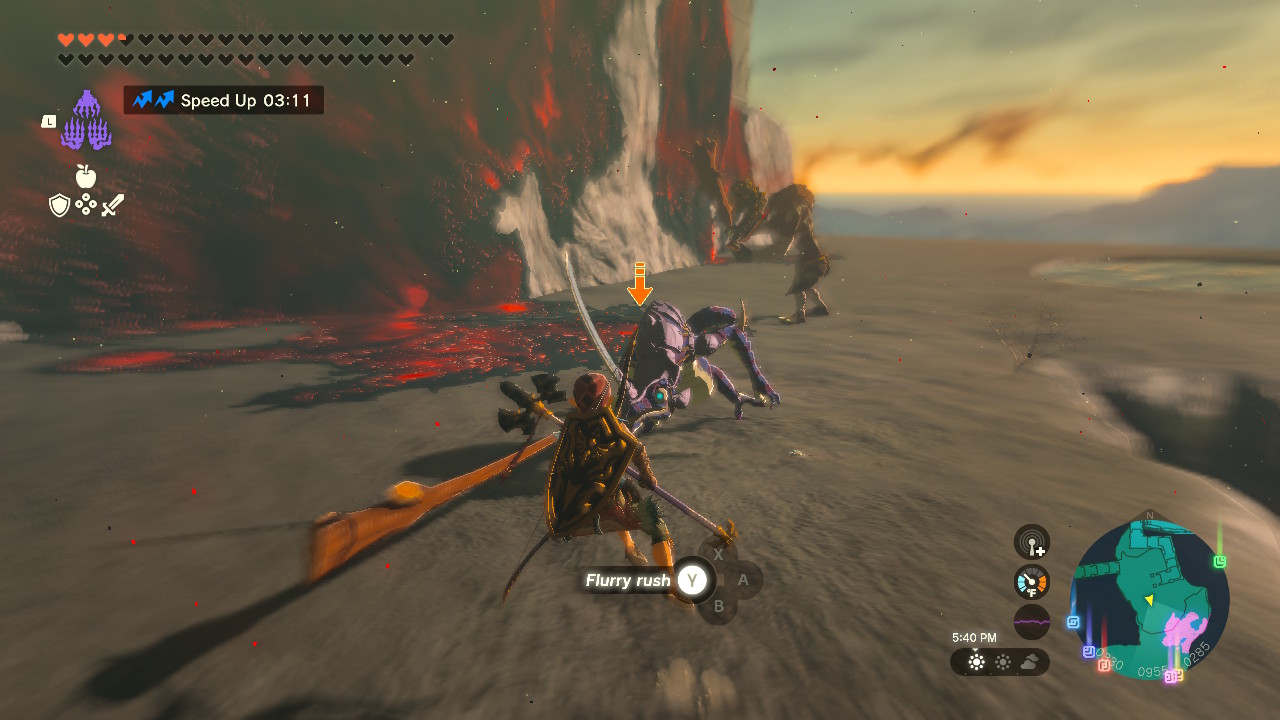
Links charges toward the Blue Lizalfos with a flurry rush.
Here’s a link to what combat looks like.
The combat in Tears of the Kingdom is smooth and fluid, and it’s the best part of the game. It is smooth because Link is a fast character who experiences time faster than the monsters.
He has 3 unique abilities which slow down time. Flurry Rushes are perfect dodges where he dodges an attack and goes for a powerful counterattack.
Recall can make weapons in motion go in reverse, but it also applies the same rule to all interactive objects. Bullet Time is when Link draws his bow in the air from mid-air and can shoot multiple arrows at enemies.
The bullet time is wild in the game because of Link’s new creative ways to launch into the air quickly, such as using rocket shields during combat.
Link can reach a maximum level in the game by wearing armor, wielding powerful weapons, and eating powerful meals to become overpowered.
This is the best way to reach Link at his maximum strength:
- Eat a level 3 attack-up meal.
- Wear level 3 attack-up armor upgraded with 84 defense points.
- Wield a fused weapon with 120 attack points, such as a Molduga Hammer.
Link's Special Skills
The Legend of Zelda, unlike other notable RPG's, doesn't have a traditional talent system or skill tree to work toward in the game. Link can use his skills most instantly. Link has special abilities, which are Ascend, Recall, Fuse, Ultrahand, and Autobuild, by completing the 4 basic shrines on Great Sky Island.
He can automatically perform his special combat skills, such as Throw Material, Shield Surf, Charged Attack, Jump Slash, Backflip, Side Hop, Perfect Guard, Bullet Time, and Flurry Rush. These skills increase his experience points during battle, which brings up the next topic.
Experience System
The game has a hidden experience system that is invisible during gameplay, which increases level scaling. The game simplifies the level scaling for all types of gamers and clarifies that the more monsters you face, the more experience Link gets, such as finding more powerful weapons and monsters. Monster parts are a way to track what you have defeated as if it is physical experience points. You can do many things with the monster parts, such as fusing them onto weapons to make them stronger and creating elaborate elixirs and monster meals.
For example, when Link defeats a Blue Moblin, he earns Blue Moblin Fangs and a Blue Moblin Horn. If it holds great weapons like a royal claymore, more enemies may wield more royal claymores. He can fuse the Blue Moblin Horn onto the Royal Claymore to defeat the next stage of monsters.
Taking on tough mini-bosses such as Lynels, Froxes, Flux Constructs, and Gleeoks will help expedite Link’s level scaling if he has the appropriate weapons to defeat them. Many mini-bosses are weak against weapons with 38 base damage or more. If Link has weak weapons, you're not prepared to defeat mini-bosses skillfully, even if it takes a lot of weak weapons to defeat them. This system is most engaging because it forces gamers to find early weapons and armor hidden in treasure, such as the Fierce Deity Armor and Sword. It will also help the gamer explore the world and see what hidden armor and weapons are available.
One of the many short ways to level scale is to farm Zonaite and use the Autobuild ability to create monster-killing devices. It includes increasing Link’s energy cell and farming many Crystalized Charges. It takes a lot of time and effort but saves combat and expedites the enemy scaling much faster. It allows gamers with fewer weapons and high Zonaite to face mini-bosses early in the game so they can farm more valuable monster parts.
In conclusion, the game's experience system invites a diversity of gameplay, allowing gamers more freedom in how they want to level up, explore Hyrule, and defeat enemies. The simple fluidity is integrated with the weapon system.
Weapons
There are many weapons in the game, including shields, bows, and an assortment of one-handed and two-handed weapons, such as swords, spears, clubs, etc. Each weapon will have its own tier, such as attack up +, durability +, long throw, quick shot, and more. Some may even have passive abilities, such as increasing the power of flurry rushes during perfect dodge. Every weapon has a base damage, and to make them stronger, fuse monster parts, Zonai devices, and other weapons and items onto them.
For example, the Fierce Deity Sword is a two-handed sword with 38 base damage. To make it even more powerful, fuse it with high-powered monster parts such as a White-Maned Lynel Saber Horn, which has 44 Fuse Attack Power. Fuse them, and now the Fierce Deity Sword becomes a White-Maned Lynel Blade with 82 base damage! That's a lot of power.
The Zonai devices give the game unlimited weapons because of Autobuild's infinite possibilities. Gamers can create monster-killing devices to defeat tough monsters and mini-bosses. An example of a monster-killing device is a Hover Stone attached with Soldier Constructs Heads and Head-Beam Emitters! Powerful Zonai weapons are Canons, Time Bombs, Flame Emitters, Shock Emitters, and Frost Emitters.
The game has many complex weapon systems.
First, weapons can be found in treasure chests all over Hyrule and cannot respawn.
The second system relies on monsters holding essential weapons and can spawn after a Blood Moon occurs. This includes the monsters. This also includes Pristine Weapons found in the Depths.
The third system is located in the Depths, where you can buy items, armor, and weapons from Bargainer Statues in exchange for Poes.
The last system is Pristine Weapons, held by shadow knights in the Depths, and it is the most complex weapon system in the game. There is no right or wrong answer to achieving the best weapons, these systems are for different gameplay styles. Causal and intermediate gamers prefer getting weapons from treasure or monsters. More advanced players favor getting weapons from Bargainer Statues or the Pristine Weapons system. Each system has pros and cons.
Treasure
The pro side of finding treasure is that most weapons are powerful or decayed with a high attack power. It also skips time for level scaling right away. The major issue is that it won't respawn in the same treasure chest if it breaks. Some weapons in treasure chests, like Biggorn's Sword, become available to Bargainer Statues. If that sword breaks, you can always get it again from Bargainer Statues.
Bargainer Statues
Buying weapons from Bargainer statues is awesome because previously found weapons from treasure chests are available to buy in exchange for Poes. Finding Poes is easy. The other upside is that you can have more than 1 Fierce Deity Sword, which is more powerful and durable than pristine weapons. Bargainer Statues help condense weapons that should be more important to you and include perks of buying armor and unique items like Bomb Flowers.
You can buy the following weapons:
- Magic Rods
- Magic Scepters
- Magic Staffs
- Sword of the Hero
- Biggorn's Sword
- Dusk Claymore
- Fierce Deity Sword
- Sea-Breeze Boomerang
The con is that you must first find the weapon hiding in treasure chests to repurchase it from Bargainer Statues. You must find all 7 Bargainer Statues and farm more than 100 Poes. It's time-consuming.
Blood Moon
The Blood Moon remains the most popular and dominant weapon system among gamers because of its reliability. Players know that specific weapons are always available. However, this is not necessarily true regarding Like-Likes, and players may need to load a screen beforehand as if it's a jackpot machine. One con is that you can accidentally overwrite your saved data if you're not careful.
The pro side is that finding weapons held by monsters can increase your experience points fighting stronger monsters. More strong monsters mean you'll find stronger weapons. The game rewards you for doing so, and achieving monster parts is a chef's kiss. The major con is that players must be skillful and willing to take on challenges because the Blood Moon makes all monsters powerful.
The best thing about the Pristine Weapon system is that decayed versions of weapons are more durable and powerful than their decayed versions. For example, a decayed Royal Guards Claymore does 32 Damage, while a Pristine Royal Guards Claymore does 39 damage. There is a whole map of Pristine Weapons, which live in specific locations, such as Pristine Gerudo weapons, which live in the Depths of Gerudo.
The cons of the Pristine Weapon system is that it requires many negative actions to keep track of to get the Pristine Weapon you want. While it may be worthwhile, spending the same amount of time getting it will be just as close to finding weapons like Biggorn's Sword and having that available at Bargainer Statues. Having to buy overpowered weapons at Bargainer Statues may discourage gamers from relying on the Pristine Weapons.
Another con of the Pristine Weapon system is that the Blood Moon resets the weapons the shadow knights originally held, and gamers have to start from scratch again. Depending on the Pristine Weapon you want, that could be a good or bad scenario. There are plenty of times when the weapon system wants you to go to your last save because it's designed like a jackpot machine, and you can accidentally overwrite your save data if you're not careful.
In conclusion, neither of these weapon systems is necessarily better than the other because it depends on how players want to play, and that's what makes these weapon systems awesome! Tears of the Kingdom's diverse weapon systems invite flexible custom gameplay and don't restrict gamers from obtaining weapons in 1 restrictive way.
Combat animaitons and effects:
The combat animations and sound effects are beyond well thought of! When fighting, there's lots of animation and sound feedback.
For example, Link makes quick-sounding grunts when he strikes with a one-handed broadsword. He makes 2 low grunting sounds with a two-handed blade as if the weapon is heavy. During combat, everything shines. Link's weapons and the monster are easy to see. Everything reacts during battle. For instance, locking onto enemies such as Boss Bokoblin allows Link to use his shield and focus on who he's fighting against. Gamers can see damage to the monster and Link. Gamers can hear Link swinging his sword and the monster making fierce and strange grunts that are alien. There's dramatic music in the background. Whenever Link does something explosive, such as shield surfing a Bomb-Barrel Shield during battle, the screen fills with fire as it explodes. Monsters react by screaming and burning in fire.
Bullet Time is in effect when Link draws his bow in the air. Whenever it is in effect, Bullet Time makes a low-zoom-like sound, and in vision, he's aiming his bow in slow motion as the enemies are still clear to see in the frame. If he makes an arrow shot, gamers get to see where it hits the monster as the monster makes a painful noise and visibly has discomfort from being shot down by an arrow.
Tears of the Kingdom Mission System:
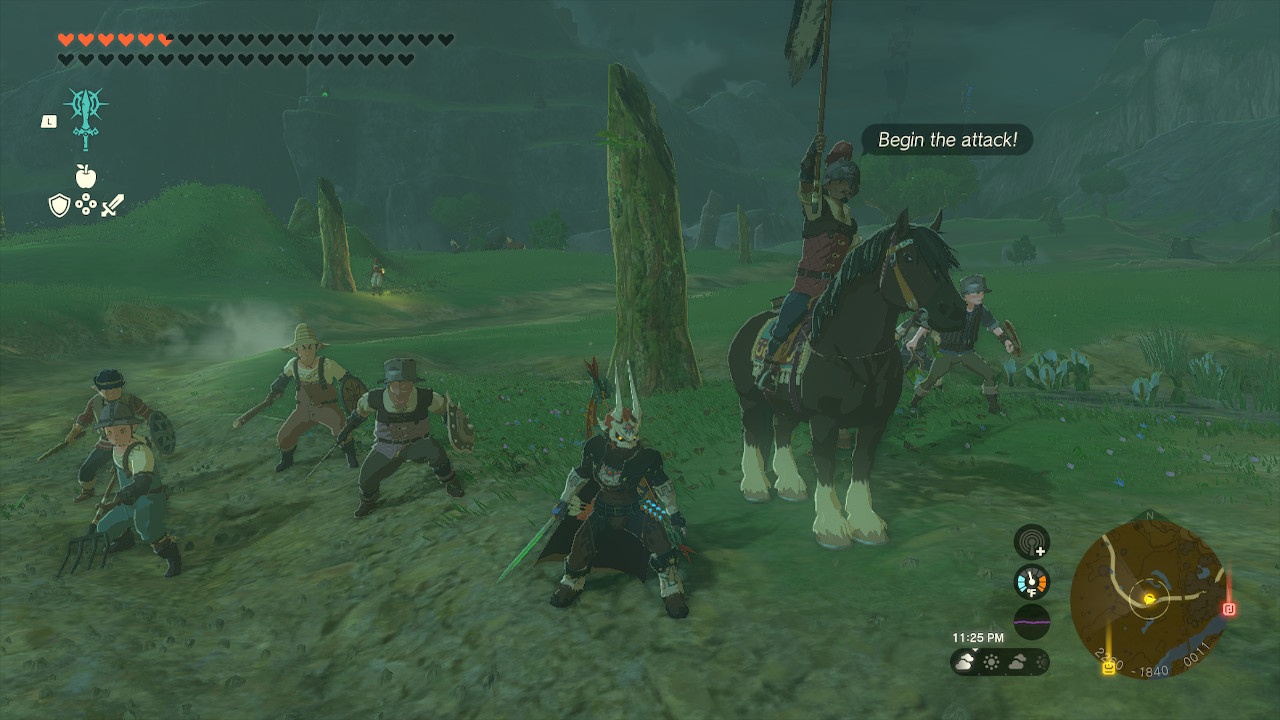
Link starts a thrilling Side Adventure, Bring Peace to Necluda.
The game has many missions. There are 4 categories:
1. Main Quests
2. Side Adventures
3. Shrine Quests
4. Side Quests
All of them make exploring fun.
Main Quests are related to the game’s overall story and involve NPC supporting characters who assist in triggering them. To trigger Main Quest events, talk to supporting characters such as Purah, Robbie, Josha, Impa, and Paya.
Side Adventures are longer side stories and involve traveling to multiple locations. You have to talk to NPC’s to trigger Side Adventures.
Side Quests are short and usually occur where the NPC's are located. You have to talk to NPC’s to trigger Side Quests.
Shrine Quests are outside puzzles that activate the shrines to erect. Interact with the shrine’s glowing hand sign to trigger the Shrine Quest.
The game does an awesome job by giving each mission a clear purpose and providing players with an array of opportunities to explore Hyrule. They can meet NPCs in a variety of ways, such as meeting them around Stables, Caves, Villages, Shores, Ruins, and Skyview Towers.
There are plenty of times when gamers can interact with NPC’s roaming around Hyrule, such as Beetle, who regularly sells insects. Great Fairies are NPCs that upgrade Link’s armor. The whole map floods with Korok’s, who are essential and annoying NPC’s who increase Link’s inventory.
Most missions and quests are exciting and give plenty of insight into what is happening around Hyrule. Of course, only some missions will be grand or exciting. The game suffers from minuscule side quests and side adventures that can feel like chores, and there’s no exciting reward after finishing the side quest. Some of them make you do nothing. Some of them can be the best side quest to experience but give you a meaningless reward that isn’t useful.
Here are a few examples:
1. A Side Quest called Cold-Endurance Contest makes players talk to Rahdo on Mount Granjh in the Gerudo Highlands. He challenges Link to survive the freezing weather without dying by standing on pillars. It’s a boring side quest where Link solves it with a cold-resistant elixir to win. As a result, you'll get 100 rupees for nothing.
2. Some Side Adventures are the most annoying but have the best prize. For instance, the Side Adventure called The Mayoral Election occurs in Hateno Village. The candidates for Mayor are Cece and Reede, and they’re keeping secrets from their supporters. Link has little to do with the result because, in the end, Cece and Reede end up working together and end their competition.
3. Cece gives Link one of her hats as a prize, which is nice but not helpful for progressing through the game. On the bright side, Cece’s Shop has become available, and gamers can buy the Hylian Shield from her.
4. One of the worst side adventures with the worst reward is Messages from an Ancient Era, where gamers encounter Wortsworth in Kakariko Village. He wants to decipher ancient Hyrule text found on stone tablets. They are in the sky, on flower-looking floating islands. When you take pictures of them, he will decipher them and give you 100 rupees each, which is very small.
What makes this one of the worst side adventures is that the deciphered story adds nothing to the main quest or story when the quest had the opportunity to. Also, it's challenging to get to some of the flower-looking floating islands. After all that work, he gives you a Zonai Survey Team Fabric design for your paraglider, making gamers bite their tongue for something more rewarding, such as more rupees or a free meal or elixir.
5. There is a similar feeling to All the Wells, where gamers encounter Fera in Lookout Landing’s well. She’s a well enthusiast and wants to find all the wells in Hyrule. She’ll reward you with rupees when you keep discovering new ones. This side quest is an extremely useful early game, where farming early rupees and getting cave materials help advance exploring Hyrule. It has a great purpose, allowing gamers to interact with caves and find great items.
After completing the side quest, Fera gives Link an All's Well glass sphere, which will make any gamer scream in frustration. However, the side adventure could have been more rewarding with something else, such as a free meal, free elixir, or early items that could have foreshadowed main quest events.
The Legend of Zelda: Tears of the Kingdom Graphics:
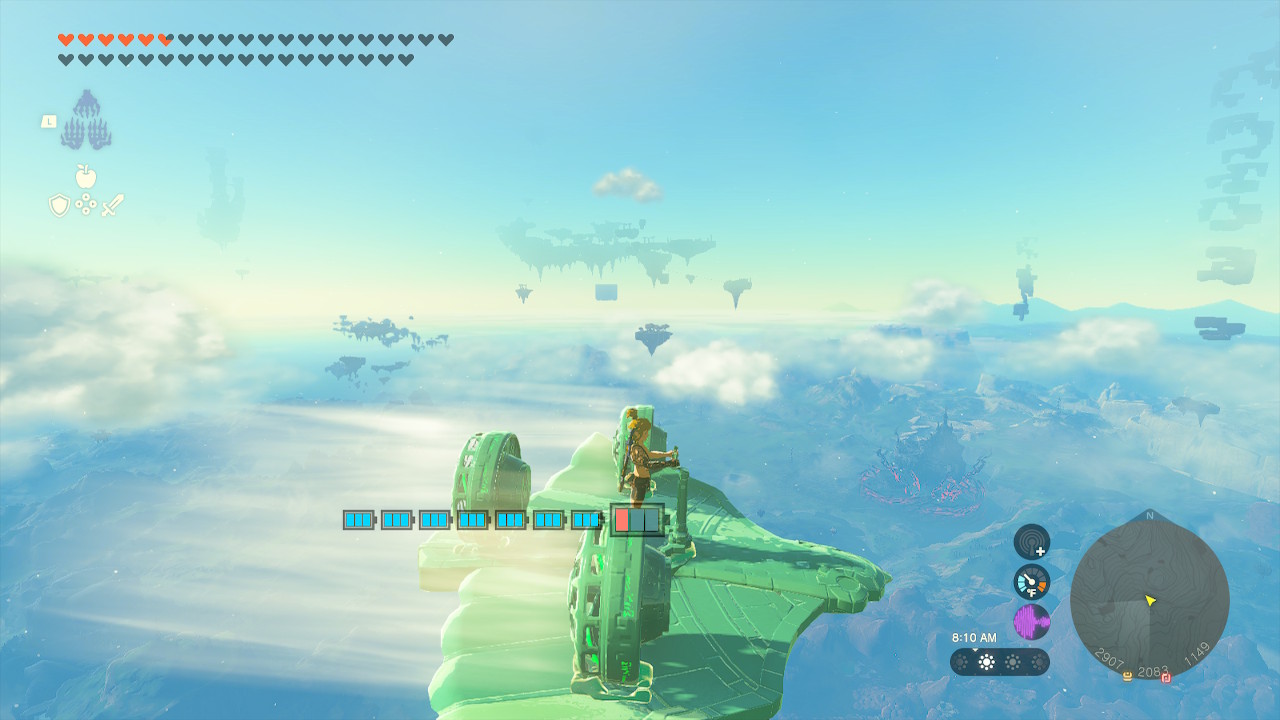
Link flies over the Sokkola Sky Archipelago.
Click here to witness Autobuild’s fascinating graphics
The graphics in Tears of the Kingdom are fantastic! Its style is soft and reminiscent of watercolor and acrylic textures like in Breath of the Wild. Tears of the Kingdom has a higher FPS and animation, and it’s much faster and smoother. It's what anyone can expect of a Zelda game.
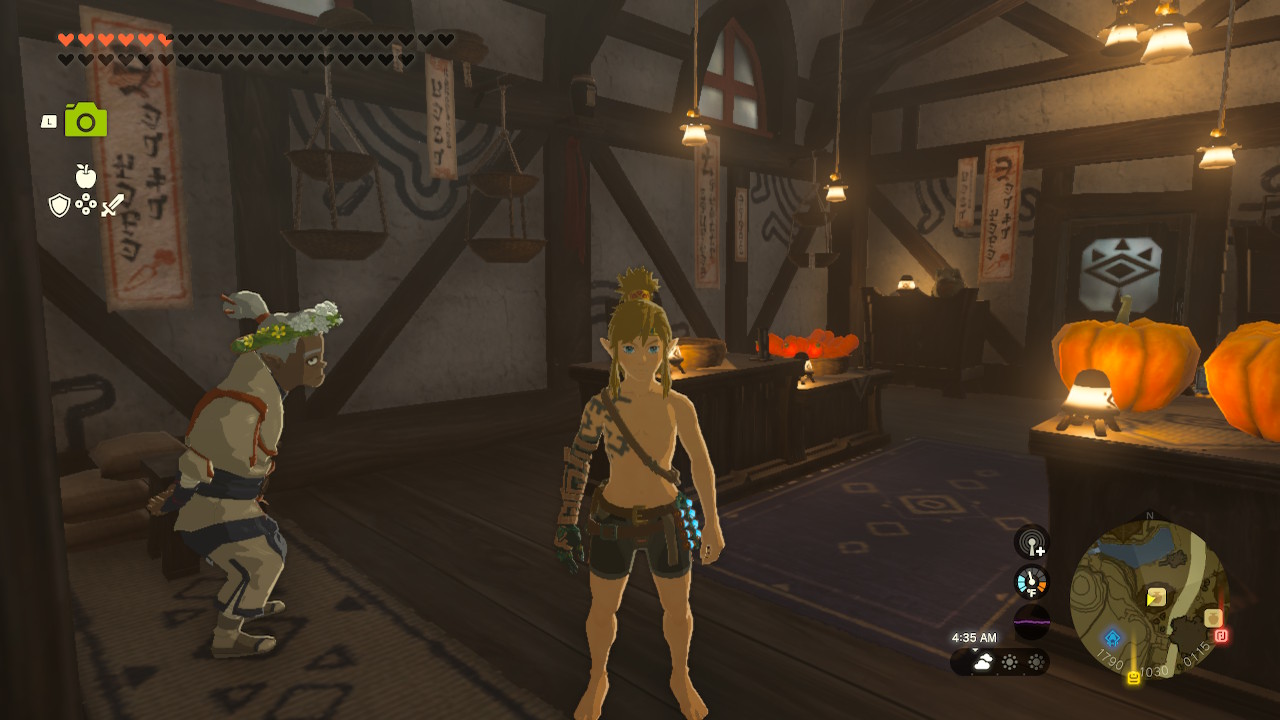
The developers took time to worldbuild everywhere.
The shops stand out in the game and feel like real shops. Certain villages sell particular food and items. The space and interior design are customary to the village. For example, in Kakariko Village, the shop sells pumpkin, goat butter, and endura carrots. All around the shop, there's Kakariko text and red robes on the walls. The engraving of the Mind's Eye is on the door frame, rugs, and lanterns, as it is a special spiritual symbol of Kakariko Village. The shop owner wears a Kakariko cotton robe with crimson and dark blue outlines. Specifically, Link's Autobuild ability creates the most impressive graphics and animation. It allows him to recreate things he already made using Ultrahand. Autobuild takes less than 5 seconds to make a gigantic Zonai device.
There are a few minor cons about the graphics, and that's when Link seathes and wields long weapons such as 2 fused spears phasing through the ground. They also phase through soft foreground elements such as stairs, rocks, and other objects that Ultrahand could pick up. The glitch is more noticeable when longer weapons have more width, such as a gnarled Thick Stick fused with a Spiked Iron Ball. It's not too bothersome for gameplay, but the developers could have fixed this easily.
This glitch doesn't do this just for fused weapons but for other normal weapons that aren't fused. For instance, a wall is supposed to be solid matter. When thrown at a wall, all weapons acknowledge the solid matter. It's silly because when Link drops weapons on the ground, the weapons precisely acknowledge the ground.
When Link wields a Royal Broadsword and strikes a wall, he's attacking his sword through the wall. However, Link isn't glitching through it because he can climb it. One of the weirdest things is that trees, walls, and all objects react to Link shooting arrows. There is always a reaction during combat when he strikes enemies with any weapon.
These glitches are relatively minor and don't affect gameplay. This may be a feature of how the developers programmed Link's abilities, Ultrahand, Recall, Fuse, Ascend, and Autobuild. It's not an exact measurement, and a theory that this may have to do with the programming and animation rules applied to Link also apply to the weapon he wields.
The game has a realistic and believable world where Link and foes are susceptible to damage. When Link gets damaged, he falls when an enemy hits him, and he lights up red as if it hurts. The damage he does varies depending on which enemies he’s facing. For example, when he strikes Chuhu Jelly, it slatters like water.
The world is full of various colors, and they are super memorable. The Skies have bright-yellow grass and light brown trees with tree leaves matching the same color of the grass. The Depths have turquoise and violet rolling rock ground with bright blue Poes in the dark distance and red and black Gloom surrounding the area. The Surface has more variety, with major biomes ranging across snow, desert, mountains, canyons, forests, seas, etc.
The days change how the Surface and Skies look during the morning, afternoon, and night. Most of Hyrule has beautiful animation in the middle of sunset, bringing other biome structures in the background that look like an art piece. Nothing looks silly in the background. The game uses brilliant animation methods, such as making mountains in the background soft, and when Link comes close to those mountains, it becomes the foreground. As another example, when Link dives off from the sky, the ground is simplified as a background. The more he comes close, the more everything becomes detailed.
The character design is amazing, and the game clarifies what Hylians look like, such as Link and Zelda, who have fair skin and blonde/light brown hair. Gerudo are women who have dark golden skin tones, such as Riju. Rito are feathery, talking human-like birds, and Gorons are rocky, rolly, polly creatures. The Zora are elegant, colorful, talking human-like fish. All their movements are natural and don't feel robotic. Each of their movements tells a story of who they are. The Rito fly. The Gorons roll. The Zora swim. Gerudos and Hylians walk. The lip-syncing matches the voice acting, and gamers can clearly define characters from one to another.
Production, Development, Community, and Where to Buy the Game
Eiji Aonuma produced the game in collaboration with Nintendo's development. He is one of the most famous video game designers, producers, and directors. He's a senior officer at Nintendo EPD.
Version 1.2.1 is the latest update on August 22, 2023. There will be no DLC for the game.
The developers truly do listen to the community. YouTube videos of Breath of the Wild influenced how they designed this game because many gamers found awesome glitches in BOTW, such as moon jumping or flying in the air with the magnesis power.
The developers understood that Tears of the Kingdom should involve the Sky and allow players to fly around. They also considered the gamer's creativity and allowed them to build with the Ultrahand ability. They knew that gamers loved messing with BOTW's limited physics. The developers made the physics in TOTK more freedom by using Ultrahand and Recall together, moving objects in motion and reverse in motion.
The Legend of Zelda: Tears of the Kingdom is $69.99 in the Nintendo eShop. The game has no in-game purchases besides Amiibo.
The game is exclusively on Nintendo Switch. PC gamers can buy an emulator to connect the Nintendo Switch to their PC gaming computer.
You can use Nintendo Gift Cards to buy the game at a cheaper price. Look at other retailers such as Target, eBay, or Amazon that might sell it for a slightly lower price.
FINAL VERDICT:
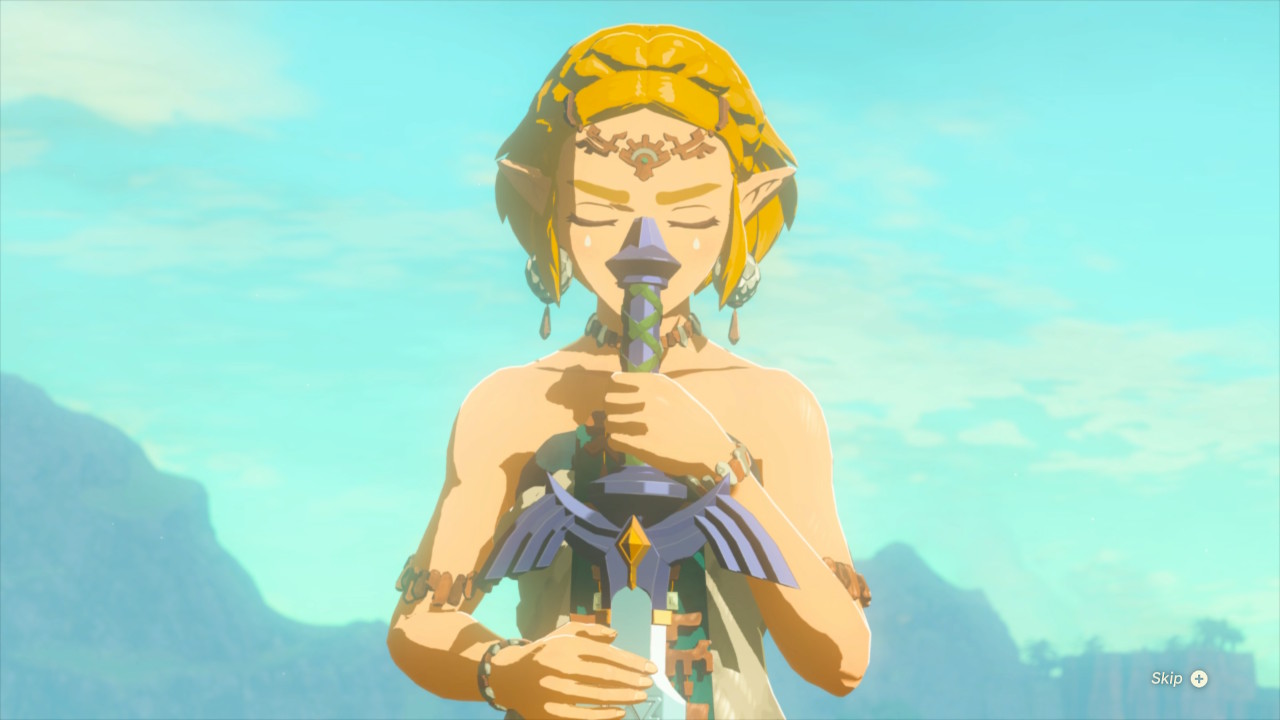
Zelda receives Link’s broken Master Sword.
Pros:
- Tears of the Kingdom has fascinating storytelling, animation, music, and gameplay making it a masterpiece.
- A Zelda game where Zelda actually does become a hero traveling through time.
- Characters are memorable.
- Intricate systems make it an engaging game.
- Link's new abilities, such as Autobuild, give gamers plenty of freedom in the game.
Cons:
- Dungeons have an inconsistent balance of risk.
- Normal Shrines puzzles lack interactivity, just use a rocket shield to solve it!
- Partial glitches from when Link holds weapons that phase through solid matter.
- Side Quests and Adventures that aren’t engaging and don't aid the gamer to advance.
Score: 9/10
You may also be interested in:
Thanks for reading!
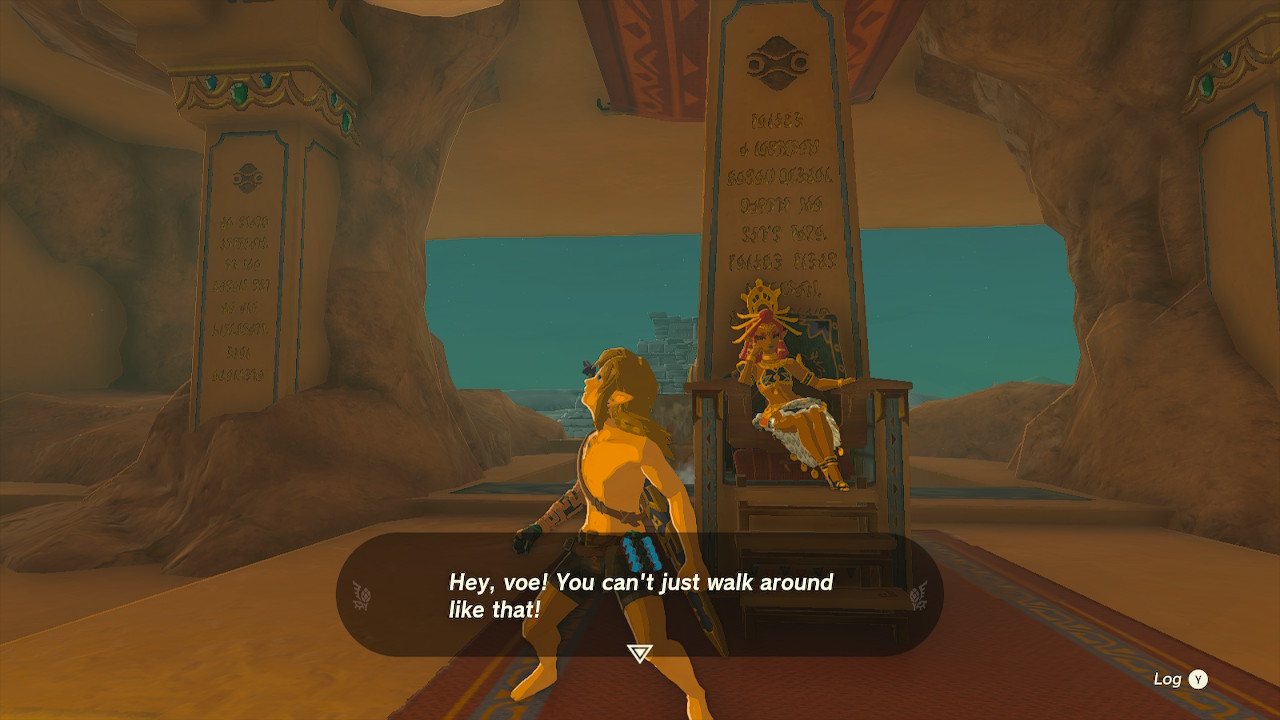
Link tries to cool off in Gerudo Town...
- Log in or register to post comments
 Home
Home PC Game Trailers
PC Game Trailers News
News Menu
Menu







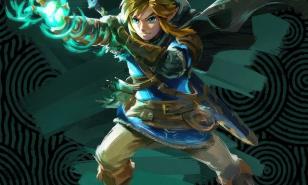
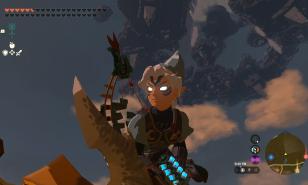
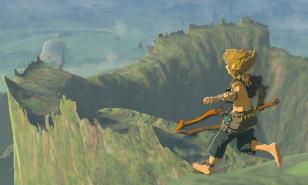
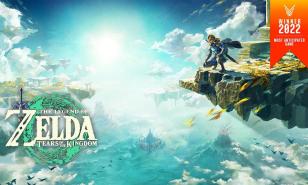

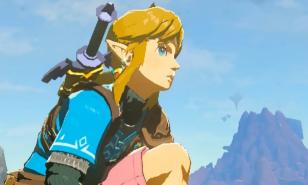

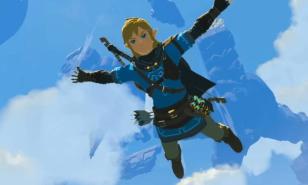
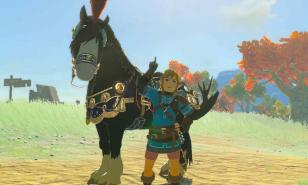
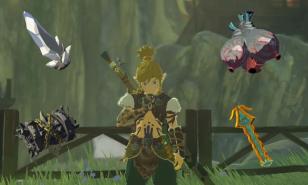
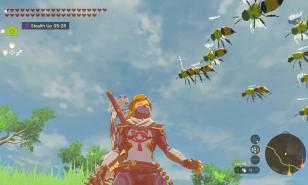
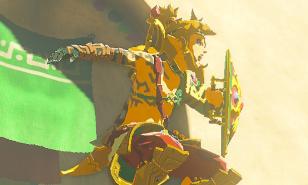
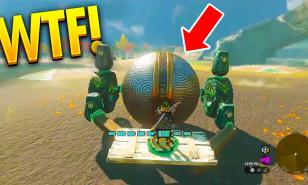
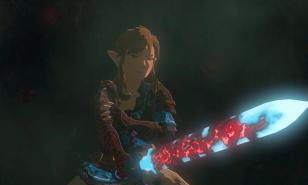
![[Top 10] Biggest AAA Games of 2023 Biggest AAA Games Released In 2023](https://www.gamersdecide.com/sites/default/files/styles/308x185-scale-crop--more-top-stories/public/top_10_aaa_games_of_2023_header.jpg)
